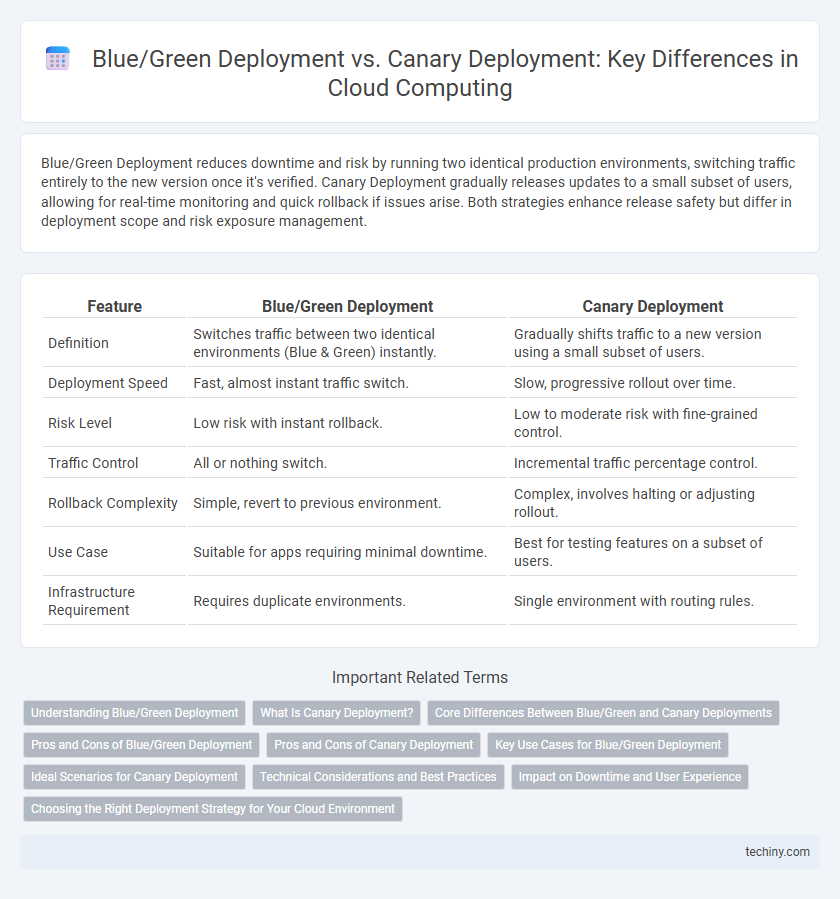Blue/Green Deployment reduces downtime and risk by running two identical production environments, switching traffic entirely to the new version once it's verified. Canary Deployment gradually releases updates to a small subset of users, allowing for real-time monitoring and quick rollback if issues arise. Both strategies enhance release safety but differ in deployment scope and risk exposure management.
Table of Comparison
| Feature | Blue/Green Deployment | Canary Deployment |
|---|---|---|
| Definition | Switches traffic between two identical environments (Blue & Green) instantly. | Gradually shifts traffic to a new version using a small subset of users. |
| Deployment Speed | Fast, almost instant traffic switch. | Slow, progressive rollout over time. |
| Risk Level | Low risk with instant rollback. | Low to moderate risk with fine-grained control. |
| Traffic Control | All or nothing switch. | Incremental traffic percentage control. |
| Rollback Complexity | Simple, revert to previous environment. | Complex, involves halting or adjusting rollout. |
| Use Case | Suitable for apps requiring minimal downtime. | Best for testing features on a subset of users. |
| Infrastructure Requirement | Requires duplicate environments. | Single environment with routing rules. |
Understanding Blue/Green Deployment
Blue/Green Deployment is a release management strategy that reduces downtime and risk by running two identical production environments, Blue and Green, where one serves live traffic while the other is updated with the new version. This approach enables seamless switching between environments, allowing instant rollback if issues arise, ensuring high availability and minimal disruption. Organizations adopting Blue/Green Deployment benefit from simplified testing, quick recovery, and improved deployment reliability in cloud computing infrastructures.
What Is Canary Deployment?
Canary deployment is a software release strategy where a new version is incrementally rolled out to a small subset of users before a full-scale launch, allowing teams to monitor performance and detect issues early. This approach minimizes risks by isolating potential problems in production environments and enables data-driven decisions for broader deployment. It contrasts with blue/green deployment, which switches between two identical environments but lacks gradual user exposure.
Core Differences Between Blue/Green and Canary Deployments
Blue/Green deployment involves switching traffic between two identical production environments, ensuring a quick rollback by redirecting all users to the stable version. Canary deployment releases new features incrementally to a small subset of users, enabling targeted monitoring and gradual exposure to minimize risk. The core difference lies in deployment strategy: Blue/Green swaps complete environments for instant cutover, while Canary deploys updates progressively for controlled testing and feedback.
Pros and Cons of Blue/Green Deployment
Blue/Green Deployment offers fast and reliable application release by maintaining two identical environments, reducing downtime and enabling quick rollback if issues occur. However, it requires double the infrastructure, increasing operational costs and resource consumption. This approach minimizes risk during updates but lacks the fine-grained user exposure control provided by Canary Deployment.
Pros and Cons of Canary Deployment
Canary deployment minimizes risks by gradually releasing updates to a small subset of users, allowing immediate detection of errors without impacting the entire user base. This approach provides real-time feedback and reduces downtime, but it requires sophisticated monitoring tools and careful traffic management to ensure proper rollout. A key drawback is the potential complexity in analyzing diverse user segments, which can slow decision-making and complicate rollback procedures.
Key Use Cases for Blue/Green Deployment
Blue/Green deployment is ideal for applications requiring zero downtime and immediate rollback capabilities, such as e-commerce platforms and financial services where user experience and transaction integrity are critical. It suits environments with stable traffic patterns that demand rapid switching between production environments without impacting end users. Enterprises often leverage Blue/Green deployment for major version upgrades, database migrations, and system-wide feature rollouts to ensure seamless transitions and reduce the risk of deployment failures.
Ideal Scenarios for Canary Deployment
Canary deployment is ideal for scenarios that require gradual release of new features to a subset of users, minimizing risk by closely monitoring system performance and user feedback before full rollout. It excels in environments with high availability demands, where rapid rollback is necessary if any issues arise. Organizations leveraging continuous delivery pipelines benefit from canary deployments to validate changes incrementally while maintaining system stability.
Technical Considerations and Best Practices
Blue/Green deployment involves maintaining two identical production environments, enabling rapid switching with minimal downtime and rollback risk, whereas Canary deployment gradually releases updates to a small subset of users, allowing real-time monitoring and targeted rollback. Key technical considerations include infrastructure automation, traffic routing, and robust monitoring to detect issues early; Blue/Green favors DNS or load balancer switching, while Canary requires progressive traffic shifting and feature flagging. Best practices emphasize automated testing, comprehensive rollback strategies, and consistent environment parity to ensure smooth transitions and mitigate deployment risks.
Impact on Downtime and User Experience
Blue/Green Deployment minimizes downtime by running two identical production environments, allowing instant traffic switch to the new version, ensuring a seamless user experience with near-zero disruption. Canary Deployment releases updates to a small subset of users initially, enabling gradual rollout and early detection of issues, which reduces risk but may cause minor user inconsistencies. Both strategies enhance reliability, but Blue/Green offers faster recovery while Canary provides controlled exposure, balancing downtime impact and user experience based on deployment goals.
Choosing the Right Deployment Strategy for Your Cloud Environment
Selecting the appropriate deployment strategy in cloud computing hinges on factors such as application complexity, risk tolerance, and resource availability. Blue/Green Deployment offers a seamless switch between two identical environments, minimizing downtime and enabling quick rollback, ideal for mission-critical applications requiring high availability. Canary Deployment provides gradual release by rolling out updates to a small subset of users, facilitating detailed monitoring and risk mitigation in dynamic or large-scale systems.
Blue/Green Deployment vs Canary Deployment Infographic

 techiny.com
techiny.com